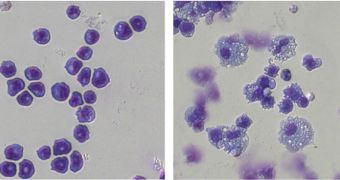During a study of genes tied to acute myeloid leukemia (AML), investigators at the Cold Spring Harbor Laboratory (CSHL) were able to identify an enhancer element that plays an important role in promoting the development of this deadly type of cancer.
This form of leukemia is fatal in 70 percent of cases, and it can only be successfully treated if caught early on. The new study reveals some insight into how a leukemia-specific stretch of DNA contributes to accelerating the uncontrolled cell growth that characterizes this cancer.
Additionally, the work provides new data on why a new class of promising AML drugs works so well against this blood cancer. The investigation was focused on the oncogene Myc. When this gene is heavily expressed, tumor cell growth is significantly accelerated.
It then follows that suppressing the activity of Myc through a targeted genetic therapy approach could lead to a marked reduction in new cancer cell growth, the CSHL scientists say. This study was led by CSHL Assistant Professor Chris Vakoc.
Details of the research appear in the November 27 issue of the journal Genes & Development. The paper reveals how Myc contributes to cancer growth by promoting the formation of proteins that support uncontrolled cellular division. Myc is active in other cancers as well, the team says.
The study revealed that Myc is nowhere near the enhancer element that facilitates its effects. In order for the two sequences of genetic code to come together, a delivery mechanism has to exist, the experts hypothesized at the beginning of their research. The SWI/SNF protein was found to fulfill that role.
“The enhancer elements we discovered are 1.7 million DNA bases away from their target gene, Myc,” Vakoc explains. His team was responsible for developing a new cancer drug against Myc back in 2011. The medication is currently undergoing phase I clinical trials.
“We were able to show that this long stretch of the genome is bent and looped in the cell nucleus in such a way that the remote enhancer segment literally touches the distant segment harboring the cancer gene,” the team leader says.
“Our results suggest that this regulatory conformation fuels the uncontrolled growth of cancer cells and may explain why the Myc gene is so uniquely sensitive to targeting with a new class of drugs being developed for leukemia,” Vakoc concludes.

 14 DAY TRIAL //
14 DAY TRIAL //